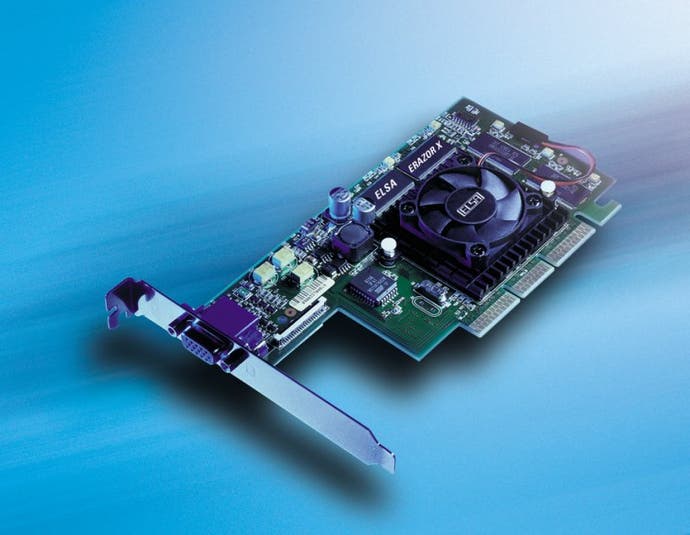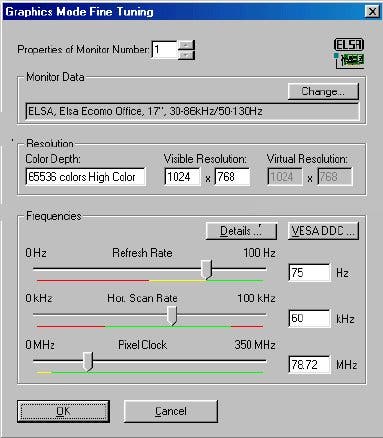Elsa Erazor X graphics card
More GeForce action from Elsa
- ElsaPrice - £180-200

DDR
The GeForce 256 is the single most powerful graphics chip to exist for the desktop PC market today. This is a well known fact, and has been true since its release in September last year.
While the performance of this chip is undisputed, there are two factions that exist within the GeForce camp. These relate to the type of memory used to partner the chip on various manufacturers' boards. While most companies are happy to produce both boards, they do charge a premium for one, and it is because of this that people may be confused by the whole idea of there being two apparently identical boards, one of which costs a significant amount less.
The difference in the memory types is that they are either standard Single Data Rate (SDR) or Double Data Rate (DDR). Just to explain briefly the difference, data can only be transmitted across a bus in time with a clock pulse. Traditionally data could only be transferred on only one edge of this clock pulse (the clock pulse is a wave), but with recent advancements data can now be transferred on both the rising AND falling edges of the clock pulse. This is very much how AGP 2x functions, and the DDR front side bus of an Athlon CPU.

The Board
Elsa are one of many companies that have produced both the SDR and DDR variants of GeForce board, and here we will be looking at the cheaper SDR flavour, the Erazor X.
The board itself breaks with the standard tradition of following a reference design. Elsa are known for their esoteric boards, and the Erazor X doesn't disappoint. When looking at the board it wouldn't be surprising for someone to wonder where the rest of it went. Elsa's unconventional design involves taking a fairly substantial chunk out of the board, toward the 15 pin connector edge of the card.
The board doesn't feature any TV-Out capabilities and, as a result, it makes sense for Elsa to have taken this chunk out, as why waste board materials when its only going to be empty space. It is a shame that there are no other output features other than a standard 15 pin monitor connector, but seeing that this is a very under-used feature it makes sense not to include it just to keep the price of the board down.
One very good thing about the Elsa board is that the supplied heatsink and fan on the GeForce chip is rather nice and solid, and has a large surface area from which to dissipate the copious amounts of heat generated by the chip.
My only annoyance with this is that while the heatsink is attached using a fairly standard thermal compound, which is more than good enough for the task, the actual contact between the chip and the heatsink isn't particularly good, as there is a slight gap between some of the chip and its heatsink. This isn't good, and it may only have affected the board that I saw, but seeing that I experienced no problems with it in testing it should be sufficient.

Drivers
Elsa have once again done a sterling job with the drivers, and have based them on the latest Nvidia reference set in order to achieve the highest performance possible.
It is nice to see that they have also added a few extras to the drivers, as all too many companies just churn out the reference drivers but replace NVIDIA company graphics with their own. While this isn't too much of a problem, it is nice to see that some (like Elsa) go a little further.
The extra driver features come mainly in the form of the monitor set up, with an extensive control app which allows for very precise tuning of the monitor. Thoughtfully they have also included a large set of pre-defined monitor scripts, although creating your own personal one isn't particularly difficult.
One very interesting feature that has popped up is something called chip guard. The idea behind this is that, should you overclock the chip or have a problem with it overheating due to a fault, chip guard will monitor this and attempt to prevent you from doing any real damage to the chip itself. Chip guard will either forcibly stop the application, crash the machine, or apparently turn the computer off. During testing I didn't encounter any problems, and so never got to see chip guard in action, but there is certainly peace of mind knowing that chip guard is there.
Elsa may not have come up with this idea (I believe Asus first came up with this solution for their own GeForce boards), but kudos to them for actually including such a program. I have yet to see anyone else implement such a feature...
Performance
The Erazor X was compared to a DDR based GeForce in order to highlight the performance differences that exist between the two.
It is clear to see from the benchmarks that the DDR GeForce is consistently faster than its SDR cousin, especially when running at higher resolutions and bit depths. It is for these reasons that DDR memory was brought in.
Now For The Science Bit...
The available memory bandwidth is the main reason for the relatively poor performance of the SDR Erazor X, in comparison to the DDR variety at least - the performance is still excellent compared to any other graphics card currently on the market!
It is easier to demonstrate this with a few simple calculations... Both varieties of GeForce have a 128bit memory bus, but while the memory runs at 166MHz for SDR memory, it reaches 300MHz for the DDR variety.
Therefore the SDR memory's bandwidth is (128/8) * 166 = 2.6Gb/sec, whereas the DDR memory's bandwidth is (128/8) * 300 = 4.8Gb/sec
Due to this rather impressive bandwidth increase, a card using DDR memory is capable of transferring more data, which the chip is all too happy to supply, and so the card doesn't lose as much of its performance at higher resolutions or bit depths.
In fact, the SDR memory becomes a major bottleneck due to a simple lack of bandwidth between the chip and the memory. Do bear in mind, both chips are running at the same clock speed, and so the ONLY factor affecting the performance is the memory bandwidth.
Conclusion
The Erazor X is a good board that performs well. It comes with a good set of drivers which are constantly updated by Elsa, and it also includes Chip Guard, which is a useful feature for anyone wanting to overclock the board. Unfortunately the performance is being held back by the memory used, and so you will never see the full power of the GeForce released on to your screen.
Now, one would have thought that by using SDR memory the Erazor X would be cheaper, but when compared to other offerings the Elsa board is still quite expensive, which is a shame as performance wise it can't offer anything more than any other SDR based GeForce board.
It is for these reasons that the ErazorX doesn't receive a higher score, but nonetheless this is another good product from Elsa, if a little expensive. Release Date - available now







